Remembering George Floyd: Yoga, Colorblind Racism, and Keys to Conscious Change
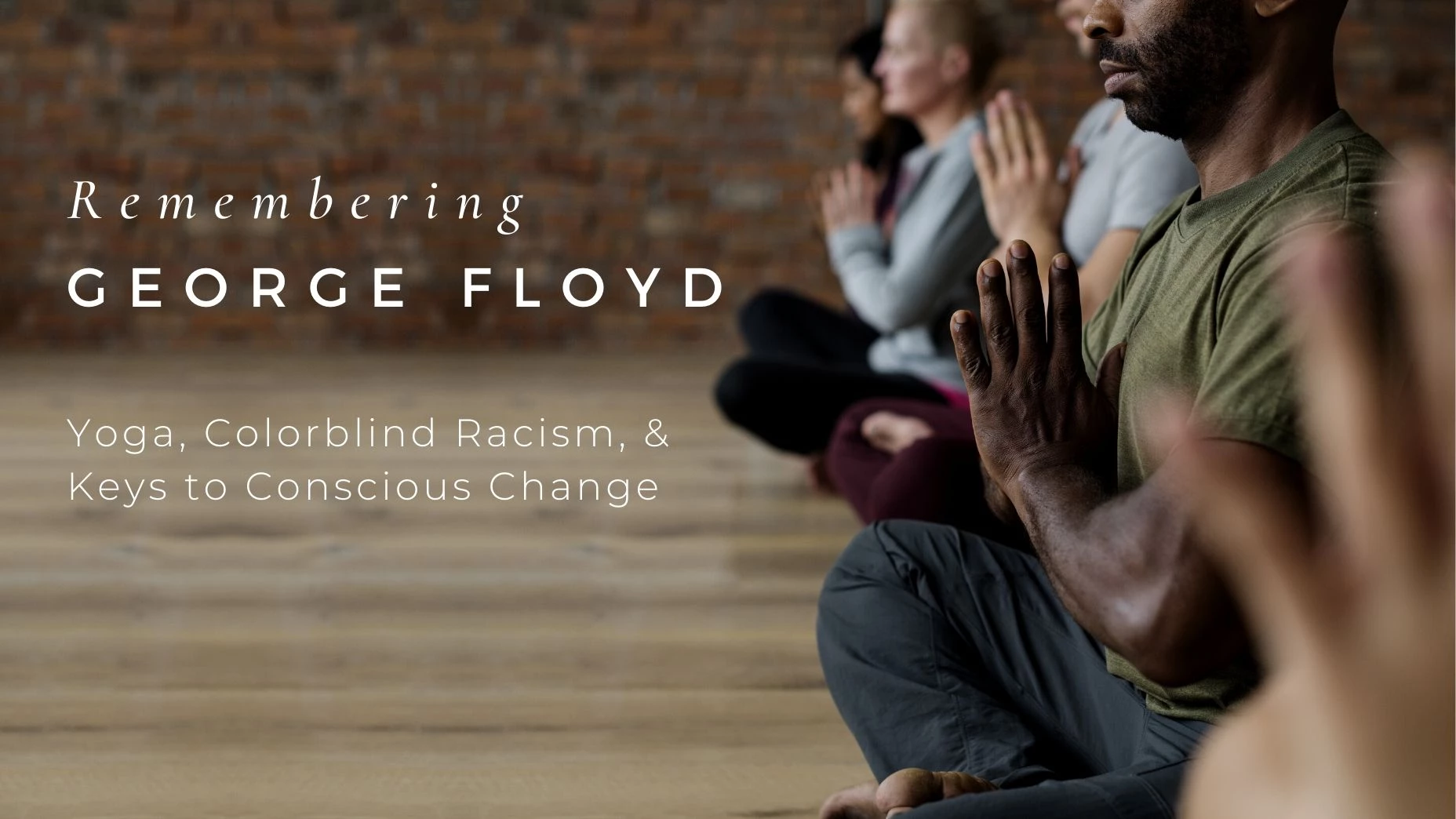
“We have to see this moment as a time for fundamental shifting.” Rev. Willam Barber
Change usually happens slowly, unseen, like the invisible growth of a plant.
But then, sometimes, change happens in one moment – a dramatic, traumatic, seismic shift that leaves our lives altered and shifts the course of history.
One moment.
8 minutes and 46 seconds, to be exact.
A moment during which three police officers inexplicably, callously, and incomprehensibly stood by. A moment during which one officer slowly, cruelly, mercilessly snuffed out the life of a man, whose only transgression was trying to use a fake $20 bill.
“I can’t breathe.”
And yes, a moment during which this most fundamental right of man – the right to breathe – was even too much to ask.
A moment that changed the world.
The callousness, cruelty, and senselessness of George Floyd’s death was so enraging, so disquieting, and such an extreme breach of basic human decency that it jolted us awake.
Not just a person, not just a city, not just a country, but the whole world. In the weeks following the murder of George Floyd, protesters throughout Europe, Australia, and South Africa ignored the COVID-19 pandemic and took to the streets, joining the battle cry “No justice, no peace.”
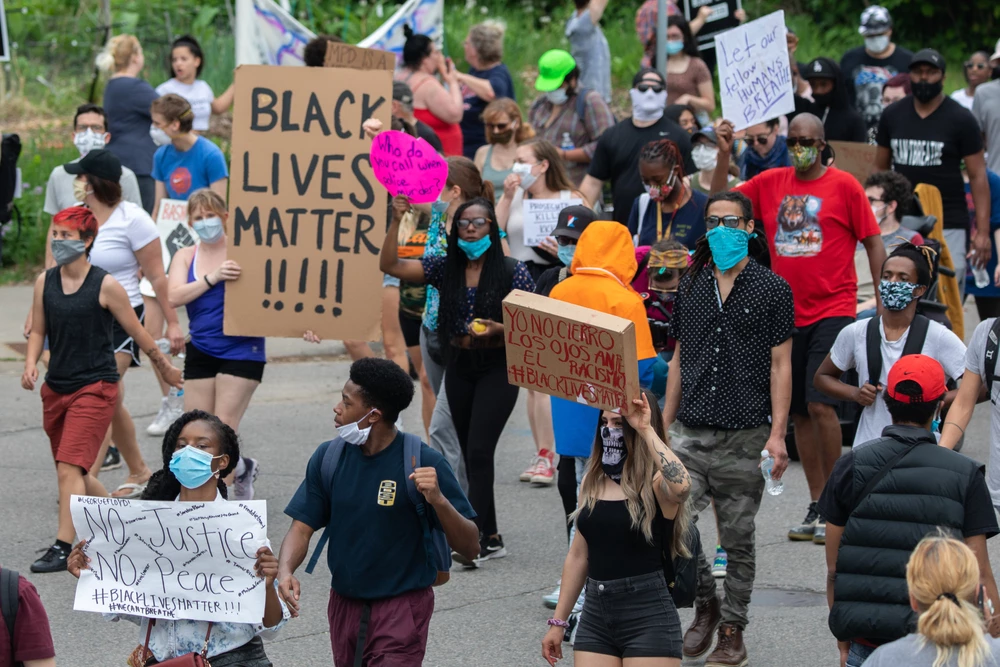
For many in the yoga community, the savage callousness of George Floyd’s death and the maddening delays in getting the officers involved charged with second-degree murder and aiding and abetting was also a wakeup call.

The stark racial injustices apparent in George Floyd’s murder put a new spotlight on what has long been a pain point in the yoga community: Questions surrounding the diversity and inclusivity in the yoga community – or rather, lack thereof.
George Floyd’s death brought racism from something that happens ‘out there’ to something so viscerally apparent, it prompted us all to start thinking about the role we each might play in affecting positive change.
It also forced us to consider painful questions: As passive bystanders – pun intended – are we allowing systemic racism to persist in our community? Is it enough to just be assured of our own politically correct views, but do nothing to change the dynamics of racial injustice we see all around us?
Seeds of Change – The Search for Greater Diversity and Inclusivity in Yoga
It is well known that racial, ethnic, and gender minorities are underrepresented in the teaching and practice of yoga across the United States.
For some years now, much work has been done to change this reality. The Black Yoga Teachers Alliance was established as a non-profit organization in 2016 by Jana Long, Maya Breuer and Lorenzo Wilkins to elevate the presence and voice of black yoga teachers in the yoga community.
The Accessible Yoga movement spearheaded by Jivana Heyman, Pamela Stokes Eggleston, Amber Karnes, and others is another leading force in these efforts. And most yoga websites – including YogaUOnline – have taken steps to ensure greater diversity and inclusivity in images used in articles and other website materials.
In addition, Yoga Alliance has responded to the cries for greater diversity and inclusivity in yoga by creating several resources and webinars on how to foster a more inclusive culture in yoga classes, including an online workshop on Creating an Inclusive Yoga Culture with Dianne Bondy, a leading voice in the Yoga for All movement.
But Is It Enough? The Invisible Scourge of Colorblind Racism
As a whole, yoga practitioners tend to be cultural creatives – progressive thinkers with – in many cases – liberal leanings. So no racism, no problem, right?
Actually, no. As we were researching a series of articles on inclusivity in yoga, we slowly became aware of just how much more there is to the problem of racism than most progressive white folks realize.

For those of us who live in a predominantly white community, attend a mainly white yoga studio, have mainly white friends – knowingly or not – we are part of the problem.
In her book, Colorblind Racism, writer Meghan Burke asks: How can colorblindness – the idea that race does not matter – be racist?
Her book provides an answer to this paradox: Dismissing or downplaying the realities of race and racism can perpetuate inequality and violence. The book documents how colorblind racism is an insidious presence in many areas of everyday life in the United States.
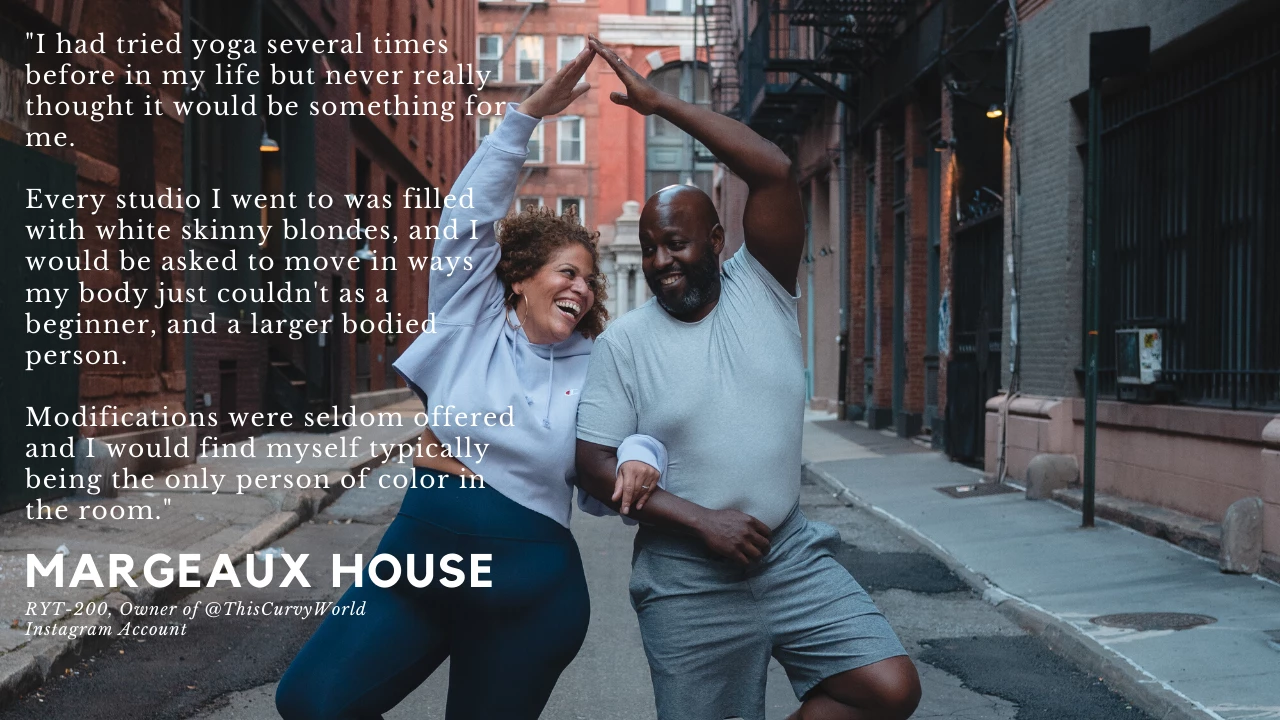
Colorblind racism, in many cases, prevents us from seeing just how systemic racial inequality is in the country in which we live. By virtue of our silence – or to be fair, cluelessness – we perpetuate that inequality.
Or as the Resource section for white folks on BlackLivesMatter.com puts it: “White silence about race allows racism and white supremacy to be maintained and normalized.”
What More Can We Do? Bringing Conscious Attention to the Factors that Shape the Yoga Community
George Floyd’s murder has brought the lack of diversity and inclusivity in the yoga community to a painful focus.
“The critical question for me, myself now is, “What are you doing now? Today?” asks yoga therapist Matthew Taylor in a Facebook discussion thread on this topic.
“Is anyone interested in partnering with me and brainstorming how we can affect positive change in this area,” wrote yoga therapist Robin Rothenberg in a Facebook post, which quickly stimulated hundreds of comments.
These are sentiments doubtlessly shared with millions in the yoga community.
But while there is willingness, there are no simple answers. The main thing we can do is to open our eyes, educate ourselves and learn more about just what it’s like – as a black person – to live in a country where traumatic events are a daily fact of life, and a simple thing like seeing a police car is a source of fear.
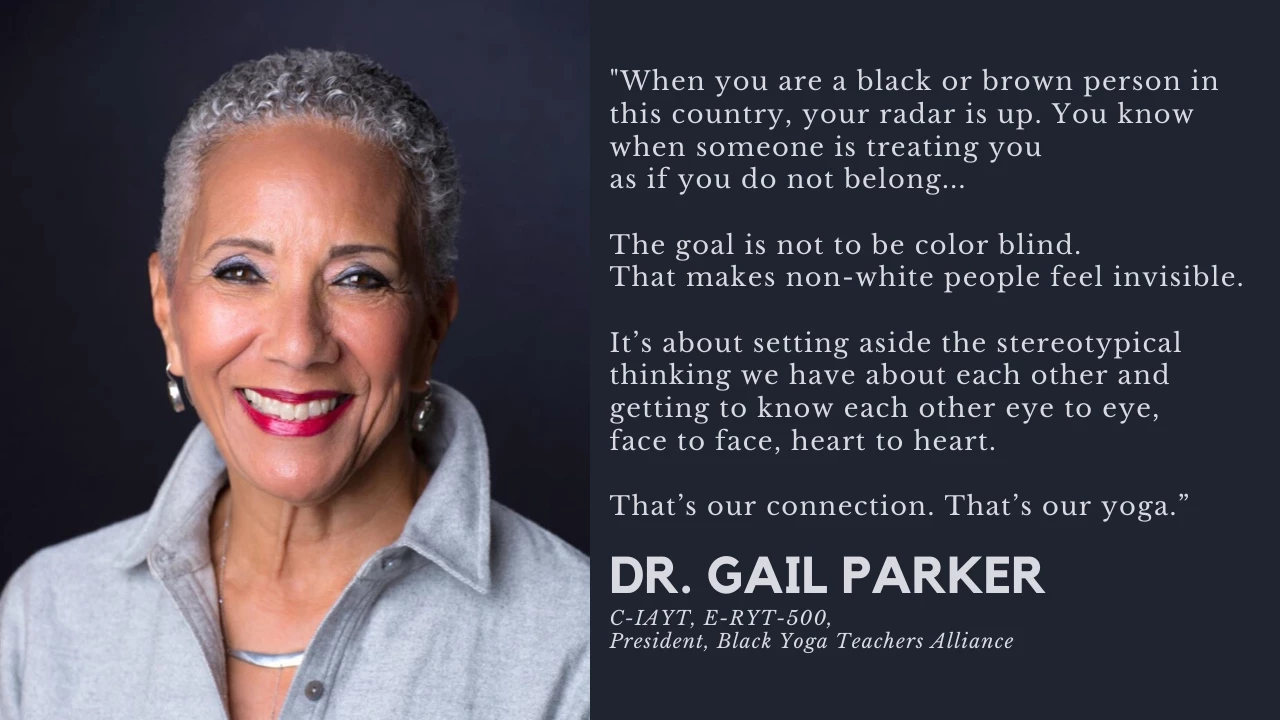
By developing greater awareness and knowledge of what is happening more broadly in the yoga community and more broadly in society around us, we don’t have to remain unwitting participants.
“One of the best ways white yoga teachers and their organizations can support black yoga teachers is to work within your white communities,” says yoga teacher Jana Long, Co-founder and Executive Director of the Black Yoga Teachers Alliance and Director of the Power of One Yoga Center. “White people who are not racists but are close to those who are in your families and among your friends and colleagues, must begin to dismantle racism in your own communities.
“A big part of the problem is the complicity of “good” and “non racist” white people going along to get along in order benefit from the privilege of whiteness. You must free yourselves first.”
As a community, we can, in the words of psychologist and yoga therapist Bo Forbes, begin “to bring conscious intention and attention to the factors shaping the future of yoga.”
So for what it’s worth, here are a few suggested steps that might be helpful as we seek to consciously shape a future of yoga that embodies the basic unity of mankind.
“It is not our differences that divide us. It is our inability to recognize, accept, and celebrate those differences.” ~Audre Lorde, The BIPOCProject.org.
1. Get to Know Your Hidden Biases.
We live in a racially divided society. As such, by virtue of our limited exposure to people of different racial groups, most people tend to develop hidden biases.
In his book Blindspot: Hidden Biases of Good People, Mahazarin Benaji characterizes hidden biases as bits of knowledge about social groups.
“These bits of knowledge are stored in our brains because we encounter them so frequently in our cultural environments,” he writes. “Once lodged in our minds, hidden biases can influence our behavior toward members of particular social groups, but we remain oblivious to their influence.”
For example, in a yoga class with predominantly white people (as many classes are), our hidden biases will tend to treat a person of color as an outsider, someone not part of the ‘yoga tribe.’
“We are not used to seeing these people,” says Gail Parker, Ph.D., President of the Black Yoga Teachers Alliance (BYTA) Board of Directors. “That shows. When you are a black or brown person in this country, your radar is up. You know when someone is unfamiliar with you and acts like it. “So what I say is, yoga teachers need to do some deep self-examination around this issue of race and ethnicity, particularly if you want to invite someone into your space.”
Realizing this implicit, hidden bias can offer a foundation for consciously counteracting it by reaching out and treating people of color as just another member of ‘the club.’
2. Walk a Mile in Their Shoes
If you, like many white people, have spent most of your life in a predominantly white environment, the stark reality of the black experience is an unknown world.
Most white people don’t attune to just how different an experience the never-fading theme of police violence and brutality is for black people, says Dr. Jonathan Kanter, University of Washington.
“We see the videos, and we are authentically horrified and saddened by what we see,” he notes. “But many of us have the ultimate privilege of changing the channel, clicking on another Facebook post. We can make it go away if we choose and the horror of the scene is quickly forgotten. We can leave it behind and go about our day.”
However, when you can’t just change the channel, the constant reality of police brutality and racial injustice takes on a whole new meaning. It becomes an ever-present source of stress and trauma.
How is the constant threat of police violence affecting the black community?
“How do you think,” writes Monnica Williams, an Associate Professor of Psychology at the University of Connecticut on PBS.
” We are sad, angry, and traumatized. We’re living in terror. This racial trauma can cause symptoms like anxiety, depression, phobias, acting-out, and feelings of hopelessness (e.g., Carter, 2007). The trauma of exposure . . . . sits on top of layers of trauma that go all the way back to slavery. It is all one and the same.”
For people in the extended yoga community, only by educating ourselves can we truly develop empathy for what it’s like to live with the century-long uncertainty, terror, and trauma created by the pervasive racial injustice in society.
If we are not familiar with what it’s like to live with that background, it creates a lack of sensitivity that can be hurtful. In such situations, even the most well-intentioned efforts can become a problem.
“I’ve heard from people going to trauma-informed yoga training who have been retraumatized, because of the lack of awareness of specific racial nuances that one experiences in a racialized culture,” notes Parker. “We live in a racialized culture, so we have to have a conversation around this. If you are in a space where a teacher says something that reminds you of a racial wound, and you have enough trust and courage to bring it up. . . . that’s where the real conversation begins.”
3. Walk the Talk
The more one gets familiar with the black experience, the more it fosters empathy and the desire to make a difference. But what can we do to walk the talk and set up dynamics that encourage greater racial inclusiveness in the yoga community?
“To engage in real conversations with your family and friends, read books, and most importantly, to take time to look inside yourself to uncover what your own history may reveal about internal biases, privileges, and prejudices is when the work begins,” notes yoga therapist Agi Mallory, C-IAYT, in a Facebook post.
“Not everyone is or should be expected to be ready to do the work right now. Many people are tired or burdened down by other responsibilities and challenges in their lives. That’s OK. Take your time.
But let’s be clear that it takes work, and it is important work that will result in huge personal growth and the kind of slow, deliberate shifts in relationship, communities, and eventually, systems that will make the world a better place.”
4. Be Part of the Solution
Becoming part of the solution starts with a process of self-examination, notes Mallory.
The important questions to ask are “Who are your teachers? Who are your students? Who are your friends? If they are devoid of POC, why is that?”
If you are a yoga student or yoga teacher, learn the steps for fostering a culturally inclusive and welcoming environment in yoga classes. If you are a studio owner, look for ways to reach out to racial communities that do not usually frequent your classes.
For yoga teachers, developing greater awareness of and sensitivity to the psychological impact of ethnic and race-based stress and trauma is an essential step toward greater inclusivity.
A great resource for this is Restorative Yoga for Ethnic and Race-Based Stress and Trauma by Gail Parker.
The book examines the topic of race-based traumatic stress and discusses “the importance of creating conscious yoga communities of support and connection, where issues of race and ethnicity are discussed openly, non-defensively and constructively.”
Parker offers a therapeutic yoga structure to help heal emotional wounds and aid in the processing of stressful experiences that can be of great value in individual and racial trauma recovery.
As the old Chinese saying goes, a journey of a thousand miles begins with a single step.
The problem of racial injustice and the racial segregation of society has been a reality for centuries. It will not go away overnight.
However, as Gail Parker notes, the goal of yoga is union. So what better place to start to build greater interracial understanding than in our own backyard?
“The goal is not to be colorblind,” notes Parker. “That makes me invisible. And it’s not about having a conversation about pain and suffering. It’s about setting aside the stereotypical thinking about black people so we can get to know each other eye to eye.”
“And that to me is what yoga is about – it’s about creating connection, feeling connected to one another. That’s our yoga.”
Also, read...
Warrior I Pose: 5 Strengthening Variations
Deepening Your Home Yoga Practice: An Interview with Judith Hanson Lasater
4 Easy Ways to Use a Sandbag in Yoga Practice
Related courses
Breath as Medicine: Yogic Breathing for Vital Aging
Yoga and Myofascial Release: Releasing Chronic Tension with the Bodymind Ballwork Method
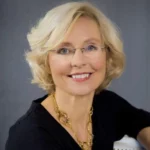
Eva Norlyk Smith, Ph.D., C-IAYT, is the founder and President of YogaUOnline. She is a lead trainer in YogaUOnline’s Yoga Wellness Educator program, an RYT-300 Yoga Alliance-approved training that focuses on giving teachers the skills they need to offer wellness courses and work with older beginners.
Eva is a trained yoga therapist at the 1,000-hour level as well as a trained bodyworker at the 500-hour level. She is the co-author of several books, including Light Years Younger with Dr. David J. Goldberg.
- Black Yoga Teachers Alliance. BYTA aims to meet the need in the yoga community to increase the diversity and inclusion of those who teach and practice, especially in communities that have traditionally had limited or no access to the practice.
- Obama.org: Anguish and Action. A great list of resources to learn what you can do to address racism and create a more just and equitable world.
- The BIPOCProject.org. The BIPOC project is a Black, Indigenous, and People of Color movement, which aims to “build authentic and lasting solidarity among Black, Indigenous, and People of Color (BIPOC), in order to undo Native invisibility, anti-Blackness, dismantle white supremacy and advance racial justice.” Read more about their work here.
- Prominent Black Yoga Teachers. Get to know some of the leading voices among black yoga teachers. Also, see #Blackyogis – a list of leading black yoga teachers on Instagram.
- Anti-Racism Resources for White People – A collection of books, podcasts, and articles that are a must-read to fully understand the anti-racism movement from the perspective of people of color.
- Race Matters – America in Crisis – A PBS Newshour Special
- The Black Experience: Hale County – This Morning, This Evening by RaMell Ross



